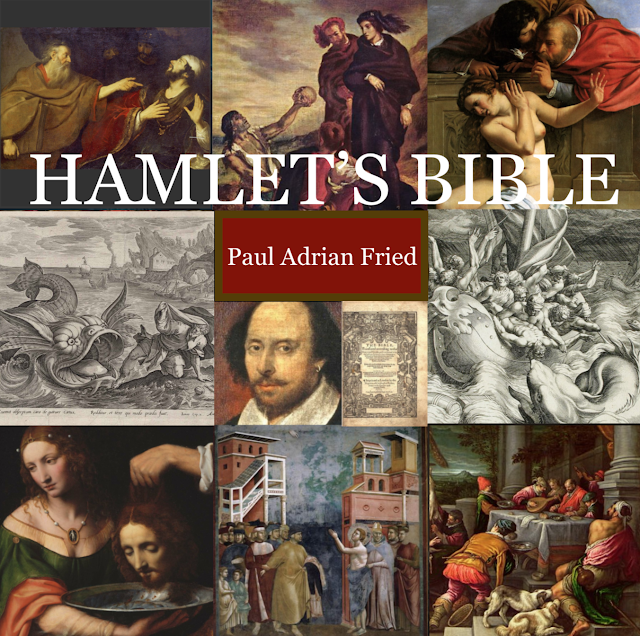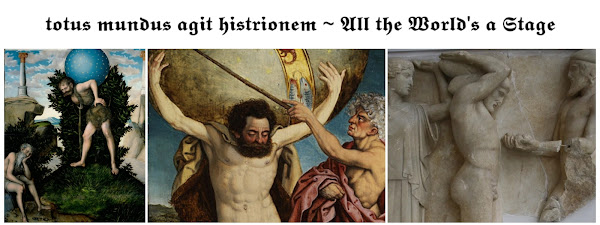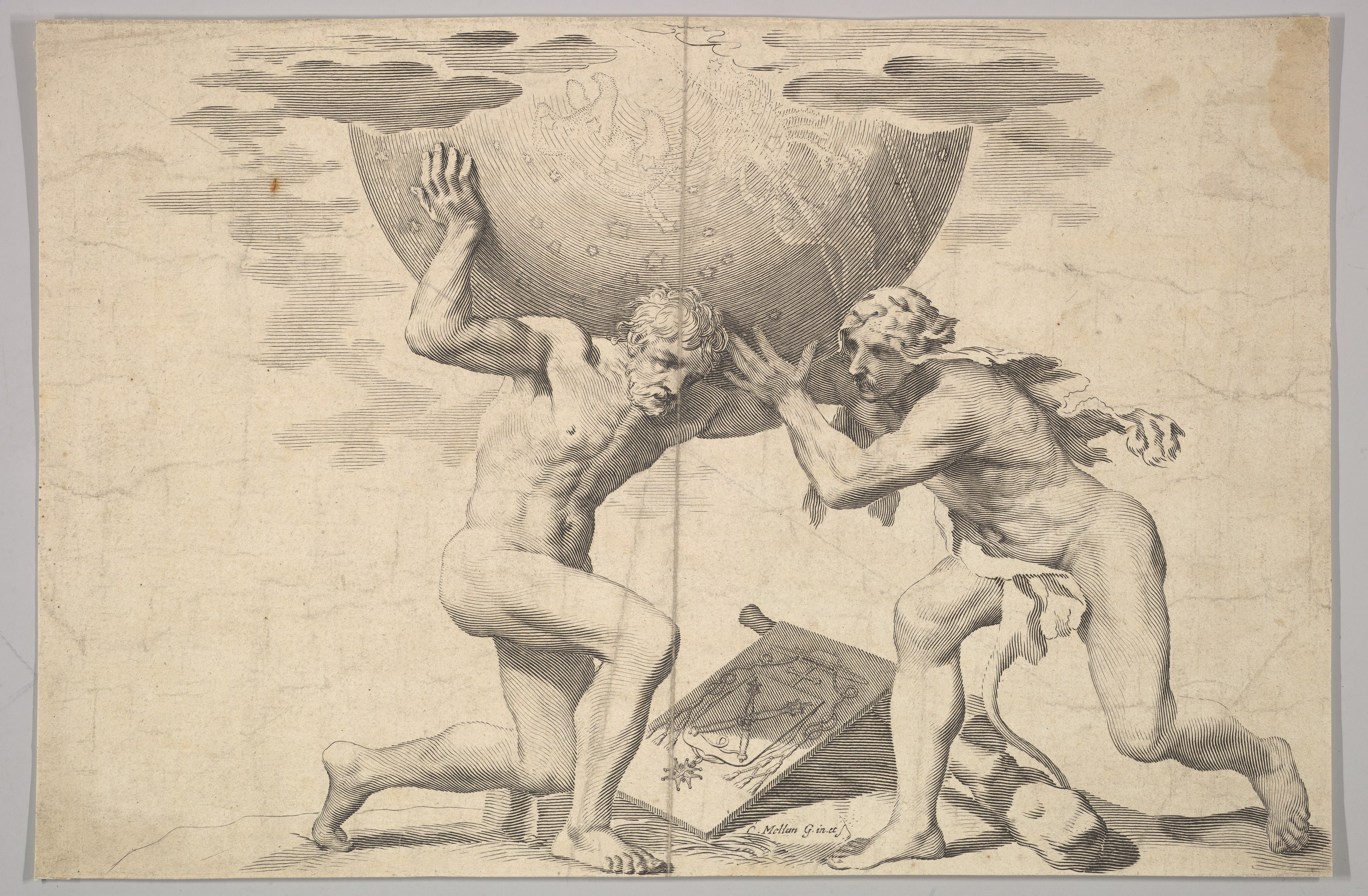"Hercules and his load," not Atlas at Shakespeare's Globe?
Rosencrantz in Shakespeare's Hamlet speaks of "Hercules and his load" (2.2.384-5) [1], which some take to be a reference to the sign or flag displayed at the Globe Theater in Shakespeare’s lifetime. [2]
Was it Hercules on the sign, not Atlas?
Or does Hamlet refer to Hercules for its thematic connections,
while the sign actually displayed Atlas?
In an Elizabethan context, the references are fraught with political implications:
Atlas was a Titan who had led a rebellion against the new order of Gods on Olympus, but failed: His punishment was to hold up the world.
In one story, Hercules temporarily held the world while Atlas did him a favor: [3]
Hercules was a son of Zeus by one of many affairs with mortal women.
Zeus’ wife Hera was jealous and tried to destroy Hercules.
In one such effort, Hera made Hercules crazy, and he killed his wife and children.
Grief-stricken Hercules was given labors to overcome his grief.
One involved holding the world for Atlas while he fetched golden apples.
There are similar themes in Hamlet:
Hercules and Hamlet bear burdens of grief;
both suffer madness.
Hera is jealous; the (alleged) ghost is jealous.
Hercules kills family members in madness;
Claudius kills his brother;
Hamlet kills his would-be father-in-law, Polonius (and tells Laertes it was madness), sends Rosencrantz and Guildenstern to their deaths, and in the end, kills his uncle.
So was it Atlas or Hercules on the Globe sign/flag in Shakespeare’s day? [4][5]
IN THE MYTHS,
Atlas was part of the old order, being punished for insurrection against the prevailing (new) order;
IN ENGLAND, was Catholicism the old order, like that of the Titans?
A Protestant Elizabeth had initially signaled that she’d be religiously tolerant in a new order (a new Olympus).
Catholics in England suffered especially after the rebellion of Northern Earls
(like a rebellion of old Titans?),
which triggered harsh retaliation and executions by Elizabeth,
which in turn triggered excommunication and death threats by the Pope,
which triggered more harsh rule and grief (heavy loads).
Some in England suffered injustices under the new order. Some acted as spies, judges, or executioners during the reigns of Mary and Elizabeth, and were complicit in the deaths of their neighbors, causing great grief —
— like the grief of Hercules, who in madness, killed his wife and children?
Does the theater motto, “All the world’s a stage,” embrace even those who kill their family or neighbors in madness, and even those of an older ideology who rebel against a new regime?
Or is this "thinking too precisely" (4.4.43) as Hamlet says,
or Horatio later, "to consider too curiously" (5.1.212)?
~~~~~~~
NOTES:
[1] All references to Hamlet are to the Folger online version:
https://shakespeare.folger.edu/shakespeares-works/hamlet/entire-play/
[2] See Jonathan Bate, How the Classics Made Shakespeare, p. 338, FN 5, which includes a short list of a number of other sources that have reflected on and debated the question of the sign or flag.
[3] See these sources for summary versions of the tale:
https://www.perseus.tufts.edu/Herakles/apples.html
https://www.history.com/topics/ancient-history/hercules
https://www.theoi.com/articles/atlas-holding-the-world-story/
[4] Posthumus praise of Richard Burbage referred to Atlas, not Hercules:
https://www.jstor.org/stable/2868416
[5] I am grateful to Pino Blasone and his recent LinkedIn post on Atlas for inspiring the idea for this post. https://www.linkedin.com/posts/pino-blasone-a1525847_in-a-metaphorical-sense-it-has-been-argued-activity-6963048120117026816-1cKC?utm_source=linkedin_share&utm_medium=member_desktop_web
IMAGES:
Top left: Hercules and Atlas. After 1537. By Lucas Cranach the Elder (1472–1553) Herzog Anton Ulrich Museum. Friedländer, Rosenberg (1978) No.: FR408A. Cranach Digital Archive. Image is public domain, via Wikimedia:
https://en.wikipedia.org/wiki/File:Lucas_Cranach_d.%C3%84._-_Herkules_und_Atlas_(Herzog_Anton_Ulrich-Museum).jpg
Top center: Hercules and Atlas with the world; anonymous, after the engraving by Heinrich Aldegrever, 1550. Second half of 16th century. Photo by Hampel Auctions. Image is public domain, via Wikimedia:
https://commons.wikimedia.org/wiki/File:Taten_des_Herakles_dt_16Jh_Atlas.jpg
Top right:
Metope from the east side of the temple of Zeus, Olympia. Here Hercules holds the Earth on his shoulders with the aid of Athena, on the right Atlas gives the Apples of the Hesperides. (470-460 BCE) Olympia Archaeological Museum. Photo by Mark Cartwright. Image is released via Creative Commons, via Wikimedia:
https://www.worldhistory.org/image/438/hercules-and-atlas/
Atlas: Photo of sculpture in Rockefeller Center, NYC. It is unclear whether this sculpture implies that Wall Street holds up the world, or that harsh and eternal punishment will come to those who challenge the existing order?
Photo date 18 October 2008, by ThreeOneFive (talk). Image is public domain, via Wikimedia:
https://commons.wikimedia.org/wiki/File:Atlas_New_York.JPG
Hercules Assisting Atlas:
Claude Mellan (1598–1688), Jean-François-Paul de Gondi, Metropolitan Museum of Art. Photo: Harris Brisbane Dick Fund, 1953:
https://www.metmuseum.org/art/collection/search/393412
Image is released via Creative Commons, via Wikimedia:
https://commons.wikimedia.org/wiki/File:Hercules_Assisting_Atlas_MET_DP822474.jpg
Hercules holds the Earth on his shoulders with the aid of Athena, on the right Atlas gives the Apples of the Hesperides. See "Top Right," above.
~~~~~~~~~~~~~~~~~~~~~~~~
Disclaimer: If and when I quote or paraphrase bible passages or mention religion in many of my blog posts, I do not intend to promote any religion over another, nor am I attempting to promote religious belief in general; only to explore how the Bible and religion influenced Shakespeare, his plays, and his age.
~~~~~~~~~~~~~~~~~~~~~~~~
~~~~~~~~~~~~~~~~~~~~~~~~~~~~~~~~~~~~~~
Thanks for reading!
~~~~~~~~~~~~~~~~~~~~~~~~~~~~~~~~~~~~~~
~~~~~~~~~~~~~~~~~~~~~~~~~~~~~~~~~~~~~~
My current project is a book tentatively titled Hamlet’s Bible, about biblical allusions and plot echoes in Shakespeare's Hamlet.
Below is a link to a list of some of my top posts (“greatest hits”), including a description of my book project (last item on the list):
https://pauladrianfried.blogspot.com/2019/12/top-20-hamlet-bible-posts.html
I post every week, so please visit as often as you like and consider subscribing.
To find the subscribe button, see the = drop-down menu with three lines in the upper left.

Was it Hercules on the sign, not Atlas?
Or does Hamlet refer to Hercules for its thematic connections,
while the sign actually displayed Atlas?
In an Elizabethan context, the references are fraught with political implications:
Atlas was a Titan who had led a rebellion against the new order of Gods on Olympus, but failed: His punishment was to hold up the world.
In one story, Hercules temporarily held the world while Atlas did him a favor: [3]
Hercules was a son of Zeus by one of many affairs with mortal women.
Zeus’ wife Hera was jealous and tried to destroy Hercules.
In one such effort, Hera made Hercules crazy, and he killed his wife and children.
Grief-stricken Hercules was given labors to overcome his grief.
One involved holding the world for Atlas while he fetched golden apples.
There are similar themes in Hamlet:
Hercules and Hamlet bear burdens of grief;
both suffer madness.
Hera is jealous; the (alleged) ghost is jealous.
Hercules kills family members in madness;
Claudius kills his brother;
Hamlet kills his would-be father-in-law, Polonius (and tells Laertes it was madness), sends Rosencrantz and Guildenstern to their deaths, and in the end, kills his uncle.
So was it Atlas or Hercules on the Globe sign/flag in Shakespeare’s day? [4][5]
IN THE MYTHS,
Atlas was part of the old order, being punished for insurrection against the prevailing (new) order;
IN ENGLAND, was Catholicism the old order, like that of the Titans?
A Protestant Elizabeth had initially signaled that she’d be religiously tolerant in a new order (a new Olympus).
Catholics in England suffered especially after the rebellion of Northern Earls
(like a rebellion of old Titans?),
which triggered harsh retaliation and executions by Elizabeth,
which in turn triggered excommunication and death threats by the Pope,
which triggered more harsh rule and grief (heavy loads).
Some in England suffered injustices under the new order. Some acted as spies, judges, or executioners during the reigns of Mary and Elizabeth, and were complicit in the deaths of their neighbors, causing great grief —
— like the grief of Hercules, who in madness, killed his wife and children?
Does the theater motto, “All the world’s a stage,” embrace even those who kill their family or neighbors in madness, and even those of an older ideology who rebel against a new regime?
Or is this "thinking too precisely" (4.4.43) as Hamlet says,
or Horatio later, "to consider too curiously" (5.1.212)?
What does it mean, for the Globe Theater, to have had a sign that alluded either to the punishment of Atlas for opposing the new Olympian regime —
or to Hercules, ready to trick Atlas, holding the world, laboring to overcome his grief—
or both?
~~~~~~~
NOTES:
[1] All references to Hamlet are to the Folger online version:
https://shakespeare.folger.edu/shakespeares-works/hamlet/entire-play/
[2] See Jonathan Bate, How the Classics Made Shakespeare, p. 338, FN 5, which includes a short list of a number of other sources that have reflected on and debated the question of the sign or flag.
[3] See these sources for summary versions of the tale:
https://www.perseus.tufts.edu/Herakles/apples.html
https://www.history.com/topics/ancient-history/hercules
https://www.theoi.com/articles/atlas-holding-the-world-story/
[4] Posthumus praise of Richard Burbage referred to Atlas, not Hercules:
https://www.jstor.org/stable/2868416
[5] I am grateful to Pino Blasone and his recent LinkedIn post on Atlas for inspiring the idea for this post. https://www.linkedin.com/posts/pino-blasone-a1525847_in-a-metaphorical-sense-it-has-been-argued-activity-6963048120117026816-1cKC?utm_source=linkedin_share&utm_medium=member_desktop_web
IMAGES:
Top left: Hercules and Atlas. After 1537. By Lucas Cranach the Elder (1472–1553) Herzog Anton Ulrich Museum. Friedländer, Rosenberg (1978) No.: FR408A. Cranach Digital Archive. Image is public domain, via Wikimedia:
https://en.wikipedia.org/wiki/File:Lucas_Cranach_d.%C3%84._-_Herkules_und_Atlas_(Herzog_Anton_Ulrich-Museum).jpg
Top center: Hercules and Atlas with the world; anonymous, after the engraving by Heinrich Aldegrever, 1550. Second half of 16th century. Photo by Hampel Auctions. Image is public domain, via Wikimedia:
https://commons.wikimedia.org/wiki/File:Taten_des_Herakles_dt_16Jh_Atlas.jpg
Top right:
Metope from the east side of the temple of Zeus, Olympia. Here Hercules holds the Earth on his shoulders with the aid of Athena, on the right Atlas gives the Apples of the Hesperides. (470-460 BCE) Olympia Archaeological Museum. Photo by Mark Cartwright. Image is released via Creative Commons, via Wikimedia:
https://www.worldhistory.org/image/438/hercules-and-atlas/
Atlas: Photo of sculpture in Rockefeller Center, NYC. It is unclear whether this sculpture implies that Wall Street holds up the world, or that harsh and eternal punishment will come to those who challenge the existing order?
Photo date 18 October 2008, by ThreeOneFive (talk). Image is public domain, via Wikimedia:
https://commons.wikimedia.org/wiki/File:Atlas_New_York.JPG
Hercules Assisting Atlas:
Claude Mellan (1598–1688), Jean-François-Paul de Gondi, Metropolitan Museum of Art. Photo: Harris Brisbane Dick Fund, 1953:
https://www.metmuseum.org/art/collection/search/393412
Image is released via Creative Commons, via Wikimedia:
https://commons.wikimedia.org/wiki/File:Hercules_Assisting_Atlas_MET_DP822474.jpg
Hercules holds the Earth on his shoulders with the aid of Athena, on the right Atlas gives the Apples of the Hesperides. See "Top Right," above.
~~~~~~~~~~~~~~~~~~~~~~~~
Disclaimer: If and when I quote or paraphrase bible passages or mention religion in many of my blog posts, I do not intend to promote any religion over another, nor am I attempting to promote religious belief in general; only to explore how the Bible and religion influenced Shakespeare, his plays, and his age.
~~~~~~~~~~~~~~~~~~~~~~~~
~~~~~~~~~~~~~~~~~~~~~~~~~~~~~~~~~~~~~~
Thanks for reading!
~~~~~~~~~~~~~~~~~~~~~~~~~~~~~~~~~~~~~~
~~~~~~~~~~~~~~~~~~~~~~~~~~~~~~~~~~~~~~
My current project is a book tentatively titled Hamlet’s Bible, about biblical allusions and plot echoes in Shakespeare's Hamlet.
Below is a link to a list of some of my top posts (“greatest hits”), including a description of my book project (last item on the list):
https://pauladrianfried.blogspot.com/2019/12/top-20-hamlet-bible-posts.html
I post every week, so please visit as often as you like and consider subscribing.
To find the subscribe button, see the = drop-down menu with three lines in the upper left.




Comments
Post a Comment